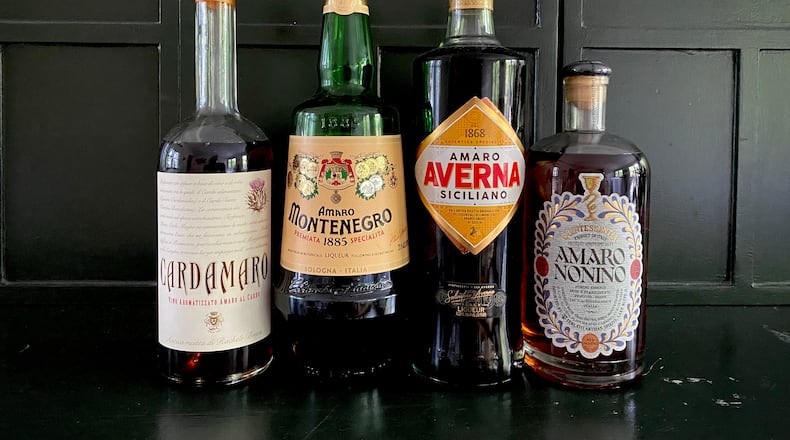Amaro means “bitter” in Italian. In the beverage world, amaro refers to a very large category of herbal liqueurs whose bitterness is the essential, defining characteristic.
An amaro is as delicious in a cocktail as it is on its own. We like to use them as a substitute for vermouth in stirred drinks, or as a spice-forward addition to a whiskey sour or daiquiri.
We generally think of amari in three sub-categories (although one could argue that there are others): aperitifs, digestifs and fernets. Most amari have four things in common: a base spirit, a bittering agent, a sweetener and water to decrease the proof.
The aperitifs, like Campari and Aperol, are the most familiar, especially with the rise of spritz culture. Aperitifs tend to be brighter and more citrus-forward in their bitterness.
Fernets, the best-known brand of which is Branca, generally are the most bitter, least sweet and highest in alcohol among amari. While fernet was bartenders’ “secret handshake” for a long time, the style is growing in popularity.
Those in the digestif category tend toward a nice balance of sweet and bitter, and have lots of baking spice aromatics. Known to stimulate the functions that aid in digestion, a post-dinner amaro has the effect of relieving the feeling of being too full.
With the impending season of indulgent holiday meals ahead, it’s a good time to stock up on digestif amari. Our four selections all hail from Italy, although you can find products in this category made in other countries, including the U.S. (High Wire Southern Amaro), Hungary (Zwack Unicum), and Germany (Jagermeister). All of these amari are versatile for fall cocktails and holiday post-meal sipping — neat or with ice. Look for them at well-stocked bottle shops.
Cardamaro — From the Piedmont region of Italy, Cardamaro is flavored with cardoons, a bitter cousin of the artichoke, not with cardamom. It has a nice balance of sweet and bitter, with notes of old-fashioned bubble gum and the vegetal bitterness of the celery-like cardoon. This wine-based amaro has 17% alcohol content, the lowest proof among our selections. It’s also the least expensive among our picks, retailing in the low to mid-$20 range.
Amaro Montenegro — This amaro from Bologna dates to 1855. The producer claims 40 ingredients in its secret formula for this spirit-based amaro, which is 23% alcohol. The lower proof and the heady note of roses make this one that drinkers of sweet liqueurs also will enjoy. A bottle sells for about $40.
Amaro Averna — Around since 1868, this Sicilian amaro’s notes of root beer, sassafras and caramel balance the bitterness and higher alcohol content (29%). Expect to pay between $37 and $45.
Amaro Nonino Quintessentia — From the northern hills of Friuli, this family recipe dates to 1897. With grappa as its base (the Nonino family is recognized for its grappas), this amaro is 35% alcohol, yet is balanced and elegant. The alpine herb blend comes through, with notes of thyme and mint. Bottles average around $50.
The Slaters are beverage industry veterans and the proprietors of the Expat and the Lark Winespace in Athens.
Read more stories like this by liking Atlanta Restaurant Scene on Facebook, following @ATLDiningNews on Twitter and @ajcdining on Instagram.
About the Author
The Latest
Featured

